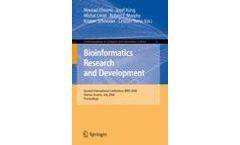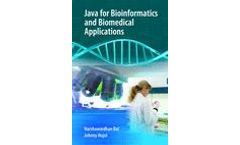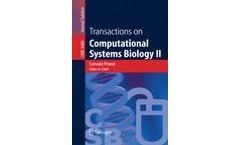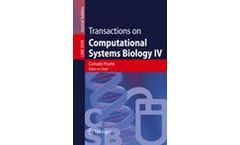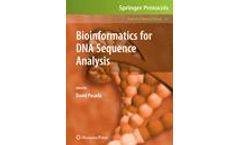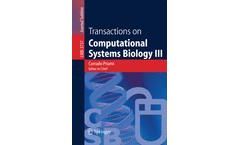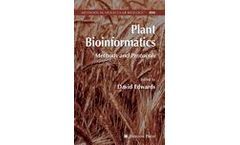bioinformatics-scientist books
20 books found
Bioinformatics is an evolving field that is gaining popularity due to genomics, proteomics and other high-throughput biological methods. The function of bioinformatic scientists includes biological data storage, retrieval and in silico analysis of the results from large-scale experiments. ...
This book constitutes the refereed proceedings of the Second International Bioinformatics Research and Development Conference, BIRD 2008, held in Vienna, Austria in July 2008. The 49 revised full papers presented were carefully reviewed and selected. 30 papers are organized in topical sections followed by 11 papers from the ALBIO workshop and 8 papers from the PETRIN ...
This book constitutes the thoroughly refereed postproceedings of the Second International Workshop on Active Mining, AM 2003, held in Maebashi, Japan, in October 2003 as a satellite workshop of ISMIS 2003. The 16 revised full papers presented together with 2 tutorial papers and an overview of the Japanese Active Mining Project went through 2 rounds of reviewing and improvement and were selected ...
The Semantic Web provides a common framework that allows data to be shared and reused across application, enterprise, and community boundaries. Advanced Semantic Web technologies are now enabling a wide range of tasks of central importance to the management of life science information. This book introduces these technologies to life science and bioinformatics professionals, illustrating their ...
The increasing availability of molecular and genetic databases coupled with the growing power of computers gives biologists opportunities to address new issues, such as the patterns of molecular evolution, and re-assess old ones, such as the role of adaptation in species diversification. This book integrates a wide variety of data analysis methods into a single and flexible interface: the R ...
A comprehensible introduction to the key biological, mathematical, statistical, and computer concepts and tools behind bioinformatics. For physical scientists, the book provides a sound biological framework for understanding the questions a life scientist would ask in the context of currently available computational tools. For life ...
Bioinformatics has ignited the imagination of scientists, entrepreneurs and the general public. At the meeting place of two fast growth disciplines, biology and computer science Bioinformatics is one of the cornerstones of the new biology. It is clearly pivotal to the translation of high throughput projects such the human genome project into ...
The field of proteomics moves rapidly, as new methods, techniques, applications, standards, models and software appear almost on a daily basis. In Proteome Bioinformatics, expert researchers explore this ever-changing field, providing the reader with a mix of review and methodology chapters which address the fundamentals of analysis methods, algorithms, data standards and databases. Chapters ...
This book constitutes the refereed proceedings of the 5th International Symposium on Bioinformatics Research and Applications, ISBRA 2009, held in Fort Lauderdale, FL, USA, in May 2009. The 26 revised full papers presented together four invited papers were carefully reviewed and selected from a total of 55 submissions. The papers cover a wide range of topics, including clustering and ...
Owing to their importance in cellular physiology and pathology as well as to recent technological advances, the study of lipids has reemerged as a major research target. However, the structural diversity of lipids presents a number of analytical and informatics challenges. The field of lipidomics is a new postgenome discipline that aims to develop comprehensive methods for lipid analysis, ...
The science and practice of medicine has undergone a fundamental change as a result of large-scale genome projects that led to the sequencing of a number of important microbial, plant and animal genomes in the last 5 years. This book aims to combine industry standard software engineering and design principles, genomics and bioinformatics and cancer research. It focuses on creating and integrating ...
Collaborative research in bioinformatics and systems biology is a key element of modern biology and health research. ...
The LNCS journal Transactions on Computational Systems Biology is devoted to inter- and multidisciplinary research in the fields of computer science and life sciences and supports a paradigmatic shift in the techniques from computer and information science to cope with the new challenges arising from the systems oriented point of view of biological phenomena. This second volume of the ...
The LNCS journal Transactions on Computational Systems Biology is devoted to inter- and multidisciplinary research in the fields of computer science and life sciences and supports a paradigmatic shift in the techniques from computer and information science to cope with the new challenges arising from the systems oriented point of view of biological phenomena. This, the 4th Transactions on ...
The storage, processing, description, transmission, connection, and analysis of the waves of new genomic data have made bioinformatics skills essential for scientists working with DNA sequences. In Bioinformatics for DNA Sequence Analysis, experts in the field provide practical guidance and troubleshooting advice for the computational analysis of ...
Not only is the quantity of life science data expanding, but new types of biological data continue to be introduced as a result of technological development and a growing understanding of biological systems. Methods for analyzing these data are an increasingly important component of modern biological research. In Bioinformatics, leading researchers in the field provide a selection of the most ...
The LNCS journal Transactions on Computational Systems Biology is devoted to inter- and multidisciplinary research in the fields of computer science and life sciences and supports a paradigmatic shift in the techniques from computer and information science to cope with the new challenges arising from the systems-oriented point of view of biological phenomena. This, the third Transactions on ...
Integrated bioinformatics solutions have become increasingly valuable in past years, as technological advances have allowed researchers to consider the potential of omics for clinical diagnosis, prognosis, and therapeutic purposes, and as the costs of such techniques have begun to lessen. In Bioinformatics Methods in Clinical Research, experts examine the latest developments impacting clinical ...
Bioinformatics is a rapidly developing field. Data volumes continue to grow and there is an increasing breadth of available data, including sequence, gene expression, protein, metabolite and phenotypic data. Novel databases are being developed for specific species or experiment types. These databases and tools may greatly assist in the application of plant biotechnology, though they require a ...
Not only is the quantity of life science data expanding, but new types of biological data continue to be introduced as a result of technological development and a growing understanding of biological systems. Methods for analyzing these data are an increasingly important component of modern biological research. In Bioinformatics, leading researchers in the field provide a selection of the most ...


